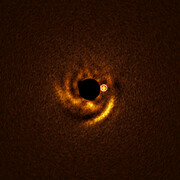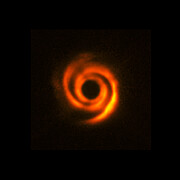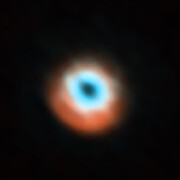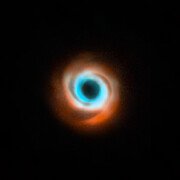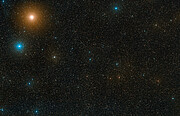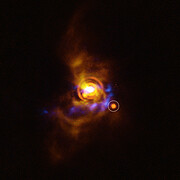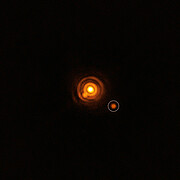Comunicato Stampa
Gli astronomi osservano un pianeta neonato mentre scolpisce la polvere intorno a sé
21 Luglio 2025
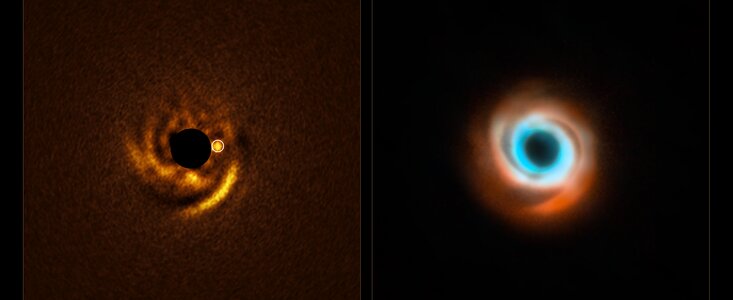
Gli astronomi potrebbero aver catturato un pianeta ancora in formazione mentre scava un intricato disegno nel gas e nella polvere che circondano la giovane stella madre. Utilizzando il VLT (Very Large Telescope) dell'ESO hanno osservato un disco planetario con prominenti bracci a spirale, trovando chiari segni di un pianeta annidato nelle regioni interne. Questa è la prima volta in cui gli astronomi hanno rilevato un candidato pianeta incastonato all'interno una spirale nel disco.
"Non potremo mai assistere alla formazione della Terra, ma qui, intorno a una giovane stella a 440 anni luce di distanza da noi, potremmo trovarci davanti alla nascita di un pianeta in tempo reale", afferma Francesco Maio, ricercatore di dottorato presso l'Università di Firenze e autore principale di questo studio, pubblicato oggi su Astronomy & Astrophysics.
Il potenziale pianeta in formazione è stato individuato intorno alla stella HD 135344B, all'interno di un disco di gas e polveri che la circonda, detto disco protoplanetario. Si stima che il pianeta in formazione abbia dimensioni doppie rispetto a Giove e una distanza dalla stella madre pari a quella di Nettuno dal Sole. È stato osservato mentre modella l'ambiente circostante all'interno del disco protoplanetario, durante il proprio sviluppo fino a diventare un pianeta completamente formato.
I dischi protoplanetari sono stati osservati intorno ad altre stelle giovani e spesso presentano strutture complesse, come anelli, lacune o spirali. Gli astronomi hanno a lungo previsto che queste strutture fossero causate da pianeti neonati, che trascinano materia orbitando intorno alla stella madre. Ma, fino ad ora, non avevano mai colto in flagrante uno di questi scultori planetari.
Nel caso del disco di HD 135344B, i vorticosi bracci a spirale erano stati rivelati in precedenza da un altro grupp di astronomi utilizzando SPHERE (Spectro-Polarimetric High-contrast Exoplanet REsearch), uno strumento installato sul VLT dell'ESO. Tuttavia, nessuna delle osservazioni di questo sistema aveva trovato finora alcuna prova della formazione di un pianeta all'interno del disco.
Ora, grazie alle osservazioni del nuovo strumento ERIS (Enhanced Resolution Imager and Spectrograph) del VLT, i ricercatori affermano di aver trovato il principale sospettato. Il gruppo di lavoro ha individuato il candidato proprio alla base di uno dei bracci a spirale del disco, esattamente dove la teoria aveva previsto la presenza del pianeta responsabile della formazione di tale struttura.
"Ciò che rende questa osservazione un potenziale punto di svolta è che, a differenza di molte osservazioni precedenti, siamo in grado di rivelare direttamente il segnale del protopianeta, che è ancora profondamente immerso nel disco", afferma Maio, che lavora presso l'Osservatorio Astrofisico di Arcetri, un centro dell'Istituto Nazionale di Astrofisica italiano (INAF). "Questo ci dà un livello di fiducia molto più elevato nell'esistenza del pianeta, poiché stiamo osservando direttamente la sua luce".
Nasce una compagna della stella
Anche un altro gruppo di astronomi ha recentemente utilizzato lo strumento ERIS per osservare una diversa stella, V960 Mon, che si trova ancora nelle primissime fasi di vita. In uno studio pubblicato il 18 luglio su The Astrophysical Journal Letters, il gruppo riporta la scoperta di una compagna della giovane stella. L'esatta natura di questo oggetto rimane un mistero.
Il nuovo studio, guidato da Anuroop Dasgupta, ricercatore di dottorato presso l'ESO e l'Università Diego Portales in Cile, fa seguito alle osservazioni di V960 Mon effettuate un paio di anni fa. Le osservazioni, effettuate sia con SPHERE che con ALMA (Atacama Large Millimeter/submillimeter Array), hanno rivelato che la materia in orbita intorno a V960 Mon è modellata come una serie di intricati bracci a spirale. Hanno anche mostrato che la materia si frammenta, seguendo un processo noto come 'instabilità gravitazionale', quando grandi grumi di materia intorno a una stella si contraggono e collassano, ognuno con la possibilità di formare un pianeta o un oggetto più grande.
"Quel lavoro ha rivelato materiale instabile, ma ha lasciato aperta la questione di cosa potrebbe accadere dopo. Con ERIS, ci siamo prefissati di trovare frammenti compatti e luminosi che indicassero la presenza di un compagno nel disco, e ci siamo riusciti", afferma Dasgupta. L'equipe ha trovato un potenziale compagno molto vicino a uno dei bracci a spirale osservati con SPHERE e ALMA. Affermano che questo oggetto potrebbe essere un pianeta in formazione o una "nana bruna", ovvero un oggetto più grande di un pianeta e che non ha acquisito massa sufficiente per brillare come una stella.
Se confermato, questo compagno potrebbe essere la prima chiara individuazione di un pianeta o di una nana bruna in formazione per instabilità gravitazionale.
Ulteriori Informazioni
Il lavoro descritto nella prima parte del comunicato è stato presentato nell'articolo “Unveiling a protoplanet candidate embedded in the HD 135344B disk with VLT/ERIS” pubblicato da Astronomy & Astrophysics (doi: 10.1051/0004-6361/202554472). La seconda parte del comunicato fa riferimento allo studio “VLT/ERIS observations of the V960 Mon system: a dust-embedded substellar object formed by gravitational instability?” pubblicato su The Astrophysical Journal Letters (doi: 10.3847/2041-8213/ade996).
L'equipe che ha realizzato il primo studio (su HD 135344B) è composto da F. Maio (Università di Firenze, Italia e INAF-Osservatorio Astrofisico Arcetri, Firenze, Italia [OAA]), D. Fedele (OAA), V. Roccatagliata (Università di Bologna, Italia [UBologna] e OAA), S. Facchini (Università di Milano, Italia [UNIMI]), G. Lodato (UNIMI), S. Desidera (INAF-Osservatorio Astronomico di Padova, Italia [OAP]), A. Garufi (INAF-Istituto di Radioastronomia, Bologna, Italia [INAF-Bologna] e Max-Planck-Institut für Astronomie, Heidelberg, Germania [MPA]), D. Mesa (OAP), A. Ruzza (UNIMI), C. Toci (European Southern Observatory [ESO], Garching bei Munchen, Germania e OAA), L. Testi (OAA, e UBologna), A. Zurlo (Diego Portales University [UDP], Santiago, Cile e Millennium Nucleus on Young Exoplanets and their Moons [YEMS], Santiago, Cile) e G. Rosotti (UNIMI).
L'equipe che ha realizzato il secondo studio (su V960 Mon) è composto soprattutto di membri del Millennium Nucleus on Young Exoplanets and their Moons (YEMS), un'iniziativa di ricerca in collaborazione con sede in Cile. Tra i principali contributori di YEMS ci sono A. Dasgupta (ESO, Santiago, Cile, UDP e YEMS), A. Zurlo (UDP e YEMS), P. Weber (University of Santiago [Usach], Cile, YEMS e Center for Interdisciplinary Research in Astrophysics and Space Exploration [CIRAS], Santiago, Cile), F. Maio (OAA e Università di Firenze, Italia), Lucas A. Cieza (UDP e YEMS), D. Fedele (OAA), A. Garufi (INAF Bologna e MPA), J. Miley (Usach, YEMS, e CIRAS), P. Pathak (Indian Institute of Technology, Kanpur, India), S. Pérez (Usach e YEMS, e CIRAS), e V. Roccatagliata (UBologna e OAA).
ALMA, l'Atacama Large Millimeter/submillimeter Array, un osservatorio astronomico internazionale, è una collaborazione fra l'Europa, la U.S. National Science Foundation (NSF) e gli Istituti Nazionali di Scienze Naturali del Giappone (NINS), in cooperazione con la repubblica del Cile. ALMA è stato fondato dall'ESO per conto dei suoi stati membri, dall'NSF in cooperazione con il National Research Council del Canada (NRC) e il National Science Council di Taiwan (NSC) e dal NINS in cooperazione con l'Accademia Sinica di Taiwan (AS) e l'Istituto di Astronomia e Scienze Spaziali della Corea (KASI). La costruzione e la gestione di ALMA sono condotte dall'ESO per conto dei suoi stati membri, dall'Osservatorio Nazionale di Radio Astronomia (NRAO) gestito dalle Associated Universities, Inc. (AUI) per conto del Nord America e dall'Osservatorio Astronomico Nazionale del Giappone (NAOJ) per conto dell'Asia Orientale. L'osservatorio congiunto di ALMA (JAO: Joint ALMA Observatory) fornisce la guida unitaria e la gestione della costruzione, del commissioning e delle operazioni di ALMA.
L'ESO (European Southern Observatory o Osservatorio Europeo Australe) consente agli scienziati di tutto il mondo di scoprire i segreti dell'Universo a beneficio di tutti. Progettiamo, costruiamo e gestiamo da terra osservatori di livello mondiale - che gli astronomi utilizzano per affrontare temi interessanti e diffondere il fascino dell'astronomia - e promuoviamo la collaborazione internazionale per l'astronomia. Fondato come organizzazione intergovernativa nel 1962, oggi l'ESO è sostenuto da 16 Stati membri (Austria, Belgio, Danimarca, Francia, Finlandia, Germania, Irlanda, Italia, Paesi Bassi, Polonia, Portogallo, Regno Unito, Repubblica Ceca, Spagna, Svezia e Svizzera), insime con il paese che ospita l'ESO, il Cile, e l'Australia come partner strategico. Il quartier generale dell'ESO e il Planetario e Centro Visite Supernova dell'ESO si trovano vicino a Monaco, in Germania, mentre il deserto cileno di Atacama, un luogo meraviglioso con condizioni uniche per osservare il cielo, ospita i nostri telescopi. L'ESO gestisce tre siti osservativi: La Silla, Paranal e Chajnantor. Sul Paranal, l’ESO gestisce il VLT (Very Large Telescope) e il VLTI (Very Large Telescope Interferometer), così come due telescopi per survey, VISTA, che lavora nell'infrarosso, e VST (VLT Survey Telescope) in luce visibile. Sempre a Paranal l'ESO ospiterà e gestirà la schiera meridionale di telescopi di CTA, il Cherenkov Telescope Array Sud, il più grande e sensibile osservatorio di raggi gamma del mondo. Insieme con partner internazionali, l’ESO gestisce APEX e ALMA a Chajnantor, due strutture che osservano il cielo nella banda millimetrica e submillimetrica. A Cerro Armazones, vicino a Paranal, stiamo costruendo "il più grande occhio del mondo rivolto al cielo" - l'ELT (Extremely Large Telescope, che significa Telescopio Estremamente Grande) dell'ESO. Dai nostri uffici di Santiago, in Cile, sosteniamo le operazioni nel paese e collaboriamo con i nostri partner e la società cileni.
La traduzione dall'inglese dei comunicati stampa dell'ESO è un servizio dalla Rete di Divulgazione Scientifica dell'ESO (ESON: ESO Science Outreach Network) composta da ricercatori e divulgatori scientifici da tutti gli Stati Membri dell'ESO e altri paesi. Il nodo italiano della rete ESON è gestito da Anna Wolter.
Links
- Articolo scientifico (Maio et al., on HD 135344B)
- Articolo scientifico (Dasgupta et al., on V960 Mon)
- Fotografie del VLT
- Per i giornalisti: iscrivetevi per ricevere i nostri comunicati sotto embargo nella vostra lingua e fate domanda per un visita strategica all'ESO (con parziale supporto finanziario) nel 2025 (Novità)
- Per i ricercatori: avete una storia da raccontare? Promuovete il vostro articolo scientifico
- Una nuova analisi dell'ESO conferma che gravi danni sarebbero causati dal complesso industriale pianificato vicino al Paranal
Contatti
Francesco Maio (for questions on the HD 135344B study)
INAF Osservatorio Astrofisico di Arcetri
Florence, Italy
E-mail: francesco.maio@inaf.it
Davide Fedele (for questions on the HD 135344B study)
INAF Osservatorio Astrofisico di Arcetri
Florence, Italy
Tel.: (+39) 055-2752-242
E-mail: davide.fedele@inaf.it
Anuroop Dasgupta (for questions on the V960 Mon study)
European Southern Observatory
Santiago, Chile
E-mail: Anuroop.Dasgupta@eso.org
Bárbara Ferreira
ESO Media Manager
Garching bei München, Germany
Tel.: +49 89 3200 6670
Cell.: +49 151 241 664 00
E-mail: press@eso.org
Joerg Gasser (press contact Svizzera)
Rete di divulgazione scientifica dell'ESO
E-mail: eson-switzerland@eso.org
Sul Comunicato Stampa
| Comunicato Stampa N": | eso2513it-ch |
| Nome: | HD135344B, V960 Mon |
| Tipo: | Milky Way : Star : Circumstellar Material : Disk : Protoplanetary |
| Facility: | Very Large Telescope |
| Instruments: | ERIS |
| Science data: | 2025ApJ...988L..30D 2025A&A...699L..10M |
Our use of Cookies
We use cookies that are essential for accessing our websites and using our services. We also use cookies to analyse, measure and improve our websites’ performance, to enable content sharing via social media and to display media content hosted on third-party platforms.
ESO Cookies Policy
The European Organisation for Astronomical Research in the Southern Hemisphere (ESO) is the pre-eminent intergovernmental science and technology organisation in astronomy. It carries out an ambitious programme focused on the design, construction and operation of powerful ground-based observing facilities for astronomy.
This Cookies Policy is intended to provide clarity by outlining the cookies used on the ESO public websites, their functions, the options you have for controlling them, and the ways you can contact us for additional details.
What are cookies?
Cookies are small pieces of data stored on your device by websites you visit. They serve various purposes, such as remembering login credentials and preferences and enhance your browsing experience.
Categories of cookies we use
Essential cookies (always active): These cookies are strictly necessary for the proper functioning of our website. Without these cookies, the website cannot operate correctly, and certain services, such as logging in or accessing secure areas, may not be available; because they are essential for the website’s operation, they cannot be disabled.
Functional Cookies: These cookies enhance your browsing experience by enabling additional features and personalization, such as remembering your preferences and settings. While not strictly necessary for the website to function, they improve usability and convenience; these cookies are only placed if you provide your consent.
Analytics cookies: These cookies collect information about how visitors interact with our website, such as which pages are visited most often and how users navigate the site. This data helps us improve website performance, optimize content, and enhance the user experience; these cookies are only placed if you provide your consent. We use the following analytics cookies.
Matomo Cookies:
This website uses Matomo (formerly Piwik), an open source software which enables the statistical analysis of website visits. Matomo uses cookies (text files) which are saved on your computer and which allow us to analyze how you use our website. The website user information generated by the cookies will only be saved on the servers of our IT Department. We use this information to analyze www.eso.org visits and to prepare reports on website activities. These data will not be disclosed to third parties.
On behalf of ESO, Matomo will use this information for the purpose of evaluating your use of the website, compiling reports on website activity and providing other services relating to website activity and internet usage.
Matomo cookies settings:
Additional Third-party cookies on ESO websites: some of our pages display content from external providers, e.g. YouTube.
Such third-party services are outside of ESO control and may, at any time, change their terms of service, use of cookies, etc.
YouTube: Some videos on the ESO website are embedded from ESO’s official YouTube channel. We have enabled YouTube’s privacy-enhanced mode, meaning that no cookies are set unless the user actively clicks on the video to play it. Additionally, in this mode, YouTube does not store any personally identifiable cookie data for embedded video playbacks. For more details, please refer to YouTube’s embedding videos information page.
Cookies can also be classified based on the following elements.
Regarding the domain, there are:
- First-party cookies, set by the website you are currently visiting. They are stored by the same domain that you are browsing and are used to enhance your experience on that site;
- Third-party cookies, set by a domain other than the one you are currently visiting.
As for their duration, cookies can be:
- Browser-session cookies, which are deleted when the user closes the browser;
- Stored cookies, which stay on the user's device for a predetermined period of time.
How to manage cookies
Cookie settings: You can modify your cookie choices for the ESO webpages at any time by clicking on the link Cookie settings at the bottom of any page.
In your browser: If you wish to delete cookies or instruct your browser to delete or block cookies by default, please visit the help pages of your browser:
Please be aware that if you delete or decline cookies, certain functionalities of our website may be not be available and your browsing experience may be affected.
You can set most browsers to prevent any cookies being placed on your device, but you may then have to manually adjust some preferences every time you visit a site/page. And some services and functionalities may not work properly at all (e.g. profile logging-in, shop check out).
Updates to the ESO Cookies Policy
The ESO Cookies Policy may be subject to future updates, which will be made available on this page.
Additional information
For any queries related to cookies, please contact: pdprATesoDOTorg.
As ESO public webpages are managed by our Department of Communication, your questions will be dealt with the support of the said Department.

